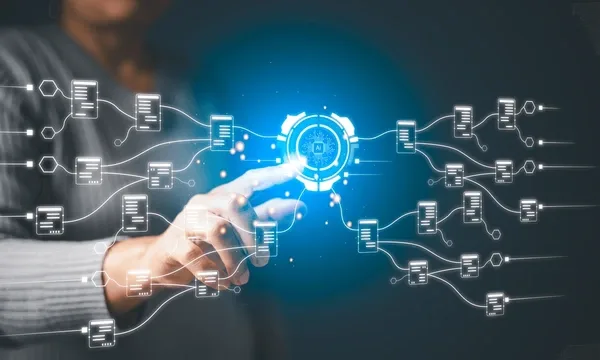
What if artificial intelligence could replace half of management, assess employee morale, and even challenge executive decisions by 2029? These bold forecasts from Gartner sparked an insightful discussion with Daryl Plummer, Managing Vice President, Chief of Research, and Chief Fellow at Gartner, about the sweeping influence of AI on the workplace.
AI is no longer just changing business operations—it’s reshaping decision-making, management, and talent strategies. Plummer’s insights highlight both opportunities and challenges for HR leaders. Here, we examine five key predictions and explore how HR can take a proactive role in integrating AI while prioritizing employee well-being and organizational success.
One recurring theme in our conversation was clear: as AI becomes deeply embedded in the workplace, transparency, ethical considerations, and trust will be critical for meaningful engagement and sustainable implementation.
AI Reshaping Organizational Structure (By 2026)
Gartner projects that by 2026, 20% of organizations will leverage AI to streamline operations, eliminating over half of middle management roles. This shift represents a fundamental redesign, moving beyond cost-cutting to redefining operational efficiency.
Business Implications:
- Redefining leadership: Managers will transition from administrative oversight to innovation and strategic roles.
- Redeploying talent: Employees will shift into creative and high-value roles as AI handles repetitive tasks.
- Enhancing engagement: Transparent communication will be essential in flatter organizations to maintain trust and alignment.
The Evolving Nature of Work
AI is not just about efficiency; it is fundamentally changing the way work is structured.
“AI isn’t just about working faster; it’s about questioning whether current processes even make sense,” Plummer explained. “If AI can redefine the work itself, do we still need the hierarchies we have today?”
Business Implications:
- Task transformation: AI is redefining job functions, requiring businesses to reconsider traditional roles.
- Human-AI collaboration: Repetitive tasks will be automated, allowing employees to focus on strategy and creativity.
- New capabilities: AI enhances human potential by enabling tasks previously thought impossible without extensive labor.
- Cultural adaptation: Leaders must embrace decentralized decision-making while aligning with company values.
Balancing AI and Employee Well-Being (By 2028)
As digital engagement intensifies, Gartner forecasts that by 2028, 70% of companies will implement anti-digital policies to counteract digital addiction and its negative effects on productivity and mental health.
“Overuse of technology is leading to cognitive and physical consequences,” Plummer noted. “Memory retention is changing, and even physical posture is being affected by excessive screen time.”
Building a Healthier Work Environment:
- Encouraging digital breaks: Establish structured tech-free periods to enhance focus and reduce stress.
- Providing mental health support: Offer access to wellness programs and psychological resources.
- Promoting human interaction: Encourage in-person collaboration to mitigate digital isolation.
Preparing for the AI-Integrated Future
AI is reshaping work at an accelerating pace. Organizations must take a phased approach to successfully integrate AI:
- Short-term (0–5 years): Build trust by educating employees and demonstrating AI’s role as an enabler, not a threat.
- Medium-term (5–10 years): Prepare for job transformations by reskilling employees and adapting workflows.
- Long-term (10+ years): Foster a culture where AI complements human potential, ensuring technology enhances rather than diminishes work experiences.
The Path Forward
AI’s rise presents both challenges and opportunities. Organizations that proactively embrace AI, redefine structures, and prioritize employee engagement will lead the transition to an AI-powered future. The key to success lies in balancing technological advancement with a human-centered approach—ensuring AI serves as a tool for empowerment rather than control. HR leaders will be instrumental in shaping this transformation, driving strategies that harness AI’s potential while safeguarding employee well-being.